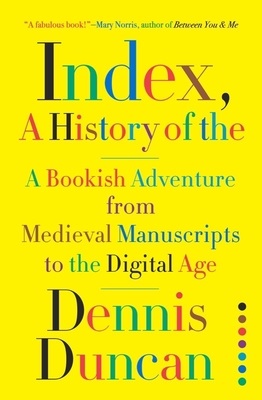Index, A History of the: A Bookish Adventure from Medieval Manuscripts to the Digital Age
- By Dennis Duncan
- W.W. Norton & Company
- 352 pp.
- Reviewed by Peggy Kurkowski
- February 23, 2022
Rollicking good read, where to find a…

When it comes to finding information quickly, what would the bookish world do without that veritable workhorse, the index? For centuries, the humble index has pointed readers toward their desired information conveniently and quickly, but its fascinating origins in the monasteries and universities of medieval Europe is not a fact readily known.
Until now, that is. In Dennis Duncan’s Index, A History of the, the genesis of this critical yet often invisible element of the book is revealed with impish insight and erudition.
The tale of the index, Duncan relates, is “a story about time and knowledge and the relationship between the two.” In its simplest utilitarian form, an index acts as a spatial indicator (i.e., something here points you to something there). But its evolution reveals a titillating history (who would’ve guessed?) of the ways in which people read and access information over time.
Duncan begins his “history of reading in microcosm” with the all-important origin stories of the two major types of indexes: the word index (or concordance) and the subject index, which grew out of the professions that used them the most: teaching and preaching.
In the 13th century, two major institutions — the university and the monastery — led the charge for detailed indexes to support their chosen mode of orderly speech: the lecture and the sermon, respectively. Each institution felt the desire to find “new, more efficient ways of reading,” and from them, Duncan traces the defining ideas that still resonate within our own word or topic searches: “Word versus concept; concordance versus subject index, and specific versus universal.”
While the concordance is faithful to the text it serves and, for example, helps a preacher locate every use of the word “hope” in the Bible, the subject index is far more conceptual and creative, having to balance “its allegiances between the work and the community of readers who will come to it.”
But the index is nothing without the locator point it, well, points to. This is the “miracle” of the page number, and Duncan employs an entire chapter to appropriately ask: “Where Would We Be Without It?” As the scroll morphed into the codex (the bound books we know today), the materiality of reading also changed, as lengths of unbroken text received “breaks” in the form of chapters, sometimes inserted by the author but many times not.
Trying to pinpoint a certain idea or subject within the book required some type of neutral locator, one not tied directly to the work itself. By the close of the 13th century, medieval indexers needed a locator with “a high degree of granularity” with “no respecter of the passage of thought…ruthlessly disinterested, apt to splice a sentence — even a word — in mid-flow.”
After chronicling the miraculous invention of the page number, Duncan further elucidates the other physical components of the codex, such as the leaf, signature, and loc, and describes clearly how they have a distinct role in the act of reading.
Perhaps the most surprising aspect of the subject index in Duncan’s meticulously researched book is the concept of the index as a battleground — and a passive-aggressive vehicle for lambasting one’s enemies. In a chapter titled “Let No Damned Tory Index My History!” the history of “sparring in the back pages” comes to giggle-worthy life. Just how could an index be a weapon of insult? Duncan relates that “it was only a matter of time before literary wags discovered the index as a convenient vehicle for their wit.”
Zeroing in on three literary arguments waged between 1698 and 1718, the bon mots are the soul of both brevity and wit. In the feud between noblemen Charles Boyle and Richard Bentley, the reader is treated to this bit of a four-page table inserted into the back of Boyle’s Boyle against Bentley. The table is titled “A Short Account of Dr. Bentley, by Way of Index” and includes such entries as:
His egregious dulness, p. 74, 106, 119, 135, 136, 137, 241
His pedantry, from p. 93 to 99, 144, 216
His Appeal to Foreigners, p. 13, 14, 15
His familiar acquaintance with Books that he never saw, p. 76, 98, 115, 232
Like “any piece of technology,” the index has evolved. For nearly 800 years, it was tied to that specific form of a book — the codex — but now, in the digital era, it is “the key technology underpinning our online reading.” While many believe computers can serve as tomorrow’s indexers, Duncan takes the opposite view and declares that humans give life to an index.
Noting that professional indexers today (overwhelmingly women and mostly unknown) provide an invaluable service to readers everywhere, he includes two different indexes at the back of his book to prove his point: one computer-generated and the other created by professional indexer Paula Clarke Bain. It is left to the human indexer, Duncan concludes, “to show how things should be done.”
A delightful ensemble of history, technology, literary lore, and information science, Index, A History of the is a joy for bibliophiles the world over.
Peggy Kurkowski is a professional copywriter for a higher education IT nonprofit association by day and major history nerd at night. She writes for several book-review publications, including Publishers Weekly, Library Journal, BookBrowse Review, the Historical Novels Review, Open Letters Review, and Shelf Awareness. She hosts her own YouTube channel, The History Shelf, where she features and reviews history books (new and old), as well as a variety of fiction. She lives in Colorado with her partner (quite possibly the funniest Irish woman alive) and three adorable, ridiculous dogs.

